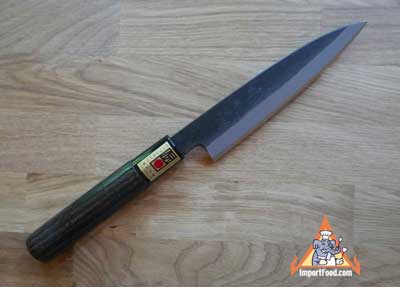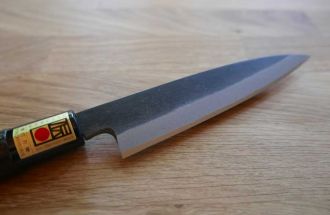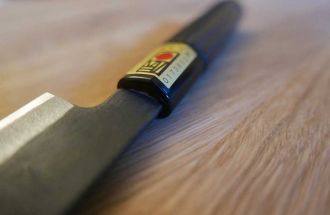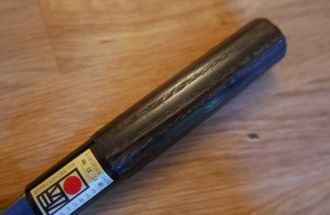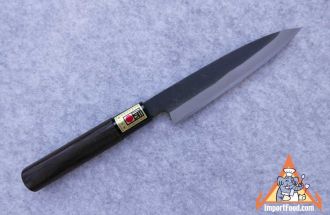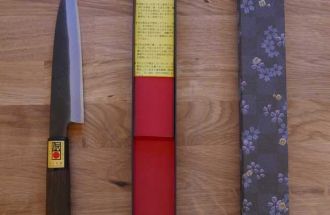Hand Crafted Office Knife, Chestnut Handle, Sakai Japan, 10.5"
Add to cartTemporarily Out of Stock This is known as an 'Office Knife' in Japan, used for cutting various fruits and vegetables. Highly useful knife that is sharpened on both sides.
This knife blade is made entirely by hand at a master craftsman's shop in Sakai, the area best known for making the finest knives of Japan. The finish work and final sharpening is done in Sakai. The handle, chestnut wood imported from USA, is installed onto the blade by hand at the same shop in Sakai.
The blade protrudes 6" out from handle. The handle is 4.5" long. Total length 10.5".
The handle is round except for one slight ridge perfectly located on the upper right (as shown). This feels excellent in the hand and is popular with Japanese and western chefs. There is a strong black plastic band seal where the blade enters into the handle, as shown.
The carbon steel (white steel / hardness grade 2 / made in Japan) is extremely hard and will keep it's sharp edge for months.
The style is called 'black finishing' as you can see the steel is worked a special way to give it a natural black look, above the blade. The black area is less likely to rust and maintains the look for the life of the knife.
Each knife comes in a strong decorative cardboard box custom fit for shipping.
Sharp Hand Forged Blade
Blade Into Chestnut Handle
Chestnut Handle
Office Knife aka Petty Knife
Knife w/Packaging
Our handmade Japanese knives are all individual works of art - starting at the hot forge where various elements are blended together to form extremely strong steel that holds a sharp edge for months of constant use.
Japanese steel has been hand crafted into prized knives for hundreds of years; a dedication to perfection you don't find anwhere else. It all starts at the forge, where elements are blended then pounded together. Next the steel is laboriously pounded into shape, goes through a long process of sharpening, the knife is carefully heated again just right so the handle can be tightly pounded on to create a seal that endures as long as possible.
We created a series of videos filmed at a facility in Japan, so you can view the various stages of each handmade knife's production:
Forged From The Elements - Blacksmithing Masters
Hand Crafted - Shaped By Experts
Sharpening The Steel
More Sharpening - Using a Sharpening Stone
Master Craftsman in Tokyo - Final Sharpening
The main difference in these knives is that they stay extremely sharp after months of constant use. This is due to the hard steel blends, which are simply too hard for machines to cut and sharpen. Machine-made knives are always created from slightly softer steel, which allows them to be cut and sharpened without a human touch. Our handmade knives of Japan are so hard that hand shaping and sharpening is the only way to reach perfection.
Why not own a knife like this in your kitchen? It really doesn't get any better. Using knives this sharp enhances not just your experience in the kitchen but also the food, because slicing with an inferior knife tears into and rips fibers. A sharp blade keeps flavors sealed in. You're also supporting the remaining hand crafted knife makers in Japan, reported to be dwinding to just a few hundred, as fewer young people are coming into the trade.
Hand crafted by master knife makers and sold to you at a very reasonable price, as we purchased directly from the maker. Similar knives are sold in Tokyo shops and abroad for much higher prices. You are getting a great deal with us on a real work of art.
Each unique knife is totally made by hand. Order now and we will have them available in a few weeks.
Hand crafted steel has enormous benefits as described, but they also rust if not properly dried after use. To prevent rust, always dry your knife, and you can wipe lightly with olive oil.
Made in Japan.
Testimonial Received April 2018:
Here is some of what I use. They are in a knife holder I made, screwed to the kitchen wall under a rack for my French copper pots and pans. Sabatier, Global, Messermeister Elite, Wustof, Forschner, Mac Pro. Others. All razor sharp. My grandfathers and an uncle were butchers. I am a journalist, but also a butcher. Boned out more deer and elk than I can count. I was a wrangler in the most remote hunting camp in the continental U.S. Just of the southeast corner of Yellowstone National Park. One season I had a hand in breaking down 33 elk and three moose with a knife my boss and outfitter made for me. Extremely sharp and held an edge.
Great as all my knives are, they seem almost dull compared to the Japanese knife I got from you. Scary sharp. I want more for my kids.
Terry Koper Oconomowoc, WI
Tips Regarding Your Handmade Knife
1. Don't use it for anything other than cooking
2. Handle with care due to the very sharp edge
3. Don't use it to cut frozen food or bones, as those require special tools
4. Never heat your knife in an open fire
5. Don't put into dishwasher or oven
6. Acid solutions, salt and water are a threat to your knife. Always wash them away and keep your knife dry by wiping with a soft cloth to prevent rust.
7. Sharpen with a wet stone once a month or when needed

